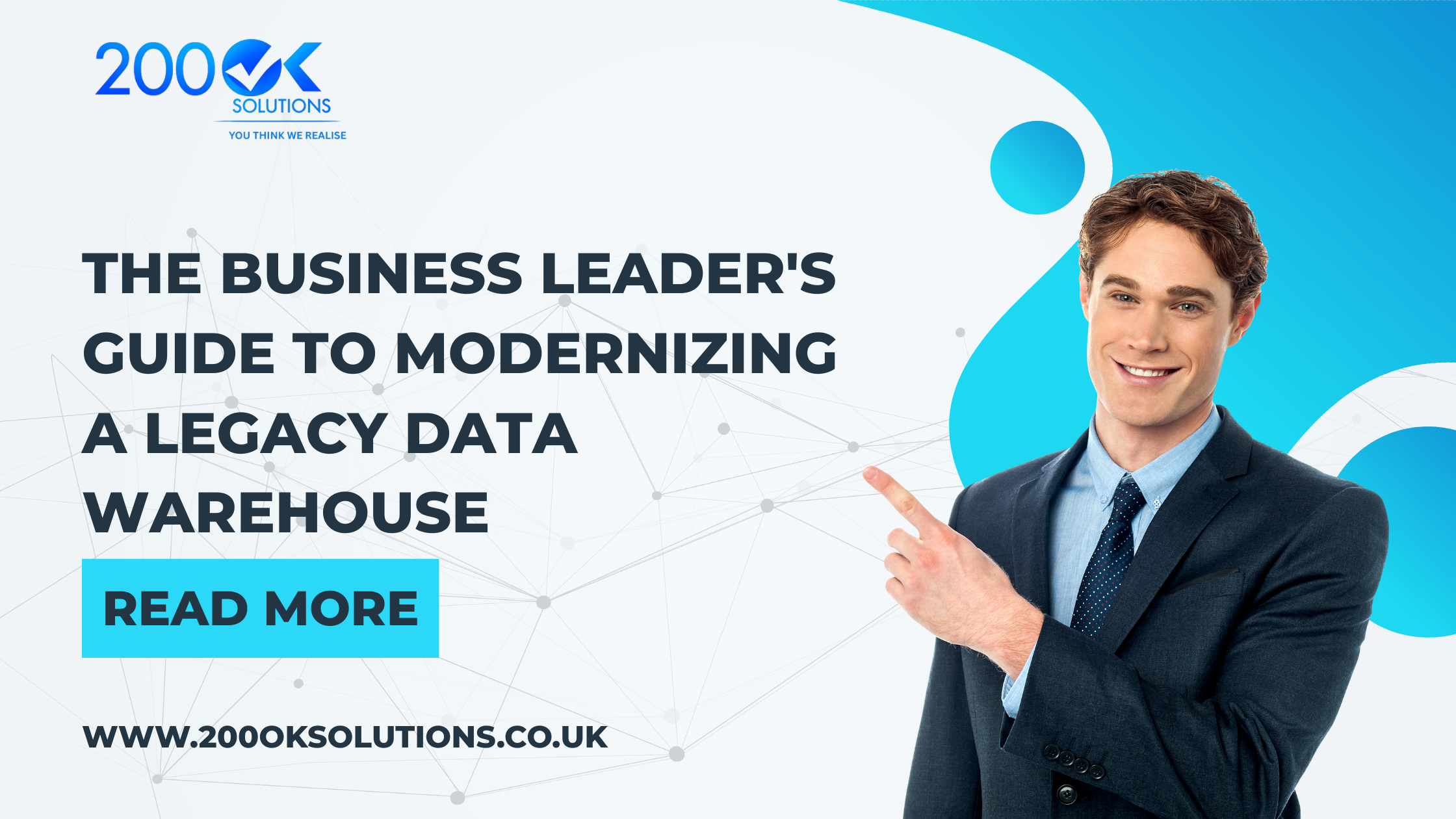Data warehouse modernization is the process of migrating your organization’s outdated data infrastructure to modern cloud-based platforms that support real-time analytics, AI integration, and scalable operations. This transformation typically involves a phased migration strategy that balances risk management with value delivery, enabling capabilities like advanced analytics, cost optimization, and enhanced security while addressing the critical limitations of legacy systems. The average modernization project takes 6–18 months and delivers ROI through reduced infrastructure costs, improved decision-making speed, and the foundation for AI-powered business intelligence.
If your organization is still running a legacy data warehouse built on decades-old technology, you’re facing more than just an IT challenge—you’re confronting a strategic business risk that grows more severe with each passing quarter. As we navigate through 2025, the gap between what legacy systems can deliver and what modern business demands require has widened into a chasm that threatens competitive viability.
This comprehensive guide to modernizing legacy data warehouses provides business leaders with the strategic framework, practical roadmap, and proven approaches needed to successfully navigate data warehouse migration while maintaining operational continuity and delivering measurable business value.
Understanding Legacy Data Warehouse Limitations: Why Modernization Can’t Wait
Before exploring strategies for data warehouse modernization 2025, let’s establish exactly what defines a legacy data warehouse and why continuing with outdated infrastructure poses escalating business risks.
What Makes a Data Warehouse “Legacy”?
A legacy data warehouse typically exhibits these characteristics:
Technical indicators:
- Built on on-premises infrastructure requiring dedicated hardware
- Relies on proprietary database technologies from the 1990s or early 2000s
- Uses rigid, pre-defined schemas that resist modification
- Processes data primarily through scheduled batch operations
- Lacks native support for semi-structured or unstructured data
- Requires specialized expertise that’s increasingly difficult to recruit
Business impact indicators:
- Reports and analytics always show “yesterday’s” data, never real-time information
- Adding new data sources requires months of development work
- Query performance degrades as data volumes grow
- Scaling requires capital expenditure and lengthy procurement cycles
- Integration with modern applications and cloud services is complex and fragile
- Cannot support machine learning or advanced analytics workloads

The Real Cost of Maintaining Legacy Systems
The challenges modernizing legacy data systems UK organizations face translate directly into quantifiable business costs:
Financial costs:
- Hardware maintenance contracts increasing 15-25% annually
- Specialized staff commanding premium salaries due to skill scarcity
- Energy consumption for aging infrastructure
- Physical data center space and cooling requirements
- Opportunity cost of delayed analytics projects
Operational costs:
- Decision-making delays due to data latency
- Lost business opportunities from inability to respond quickly to market changes
- Customer dissatisfaction from inability to deliver personalized experiences
- Competitive disadvantage against digitally-native competitors
Risk costs:
- Security vulnerabilities in unsupported software versions
- Compliance risks as regulations evolve beyond legacy system capabilities
- Business continuity risks from aging hardware approaching end-of-life
- Reputational damage from potential data breaches
For UK businesses operating in regulated sectors—financial services, healthcare, retail, public sector—these risks compound. The legacy data warehouse migration to cloud UK has become not merely advantageous but essential for survival.
The Modern Data Warehouse Advantage: Core Capabilities for Business Transformation
Understanding what modern data warehouse platforms deliver helps frame the business case for data modernization. These platforms represent fundamental architectural evolution, not incremental improvement.
Cloud-Native Architecture Benefits
Cloud data warehouse platforms provide capabilities impossible with legacy systems:
Elastic scalability:
- Automatically scale compute resources up during peak demand
- Scale down during quiet periods to minimize costs
- Add storage without infrastructure procurement
- Support unpredictable workload spikes without performance degradation
Consumption-based economics:
- Shift from capital expenditure to operational expenditure
- Pay only for resources actually consumed
- Eliminate over-provisioning required by fixed infrastructure
- Achieve predictable, transparent cost structures

Simplified operations:
- Cloud provider manages infrastructure, security patches, and upgrades
- Eliminate dedicated infrastructure management teams
- Deploy new capabilities in days rather than months
- Focus IT resources on business value rather than maintenance
Advanced capabilities:
- Native machine learning and AI integration
- Real-time data processing alongside batch operations
- Support for structured, semi-structured, and unstructured data
- Built-in data sharing and collaboration features
Real-Time Analytics and Decision Intelligence

One of the most transformative aspects of data warehouse modernization is shifting from historical reporting to real-time decision intelligence.
Legacy data warehouse systems operate on batch cycles—extract data overnight, transform it, load it into the warehouse, then make it available to users the next morning. This 12-24 hour delay renders the data obsolete for time-sensitive decisions.
Modern data warehouse platforms support streaming data ingestion and real-time query processing:
Operational use cases:
- Dynamic pricing that responds to competitor actions within minutes
- Fraud detection that flags suspicious transactions as they occur
- Supply chain visibility showing current status across all nodes
- Customer experience personalization based on immediate behavioral signals
Strategic use cases:
- Market opportunity identification from trending social media sentiment
- Risk monitoring with immediate alerts when thresholds are exceeded
- Performance tracking with real-time dashboards for executives
- Competitive intelligence aggregated from multiple real-time sources
For UK businesses in sectors like financial services, retail, and logistics, the competitive advantage of real-time intelligence cannot be overstated. Organizations that complete business leaders data warehouse modernization initiatives report decision cycle reductions of 50-90%, translating directly to revenue capture and risk mitigation.
How to Migrate Legacy Data Warehouse: Strategic Approaches and Methodologies
The data warehouse modernization roadmap UK organizations should follow depends on multiple factors: current architecture complexity, business urgency, available resources, and risk tolerance. However, proven approaches provide templates for success.
Assessment Phase: Understanding Your Starting Point
Before selecting migration strategy, conduct comprehensive assessment:
Technical discovery:
- Document all data sources feeding the current warehouse
- Map data flows and transformation logic
- Inventory reports, dashboards, and analytical applications
- Identify integration points with operational systems
- Assess data quality and cleansing requirements
- Evaluate current performance baselines and pain points
Business requirements gathering:
- Interview stakeholders across functions to understand current limitations
- Identify priority use cases that modernization should enable
- Define success criteria and key performance indicators
- Establish timeline constraints and budget parameters
- Document compliance and regulatory requirements
- Assess organizational readiness for change

Skills and resource evaluation:
- Inventory current team capabilities and experience
- Identify skill gaps requiring training or recruitment
- Evaluate partner and consultant needs
- Assess whether in-house expertise or managed services make sense
- Develop change management and training strategies
This assessment phase typically requires 6-12 weeks but provides foundation for all subsequent planning. Rushing through assessment inevitably creates problems during execution.
Migration Strategy Selection: Choosing Your Approach
Strategies for data warehouse modernization 2025 generally fall into three categories, each with specific advantages and trade-offs:
1. Lift and Shift Migration
This approach replicates existing structure in the cloud with minimal architectural changes.
Best for:
- Organizations under time pressure to exit aging infrastructure
- Situations where current architecture is well-designed and performing adequately
- First step in phased modernization journey
- Teams with limited cloud expertise
Advantages:
- Fastest migration timeline (typically 3-6 months)
- Lowest implementation risk
- Minimal business disruption
- Immediate infrastructure benefits (reliability, reduced maintenance)
Limitations:
- Doesn’t capture full benefits of modern data warehouse capabilities
- May perpetuate existing architectural limitations
- Likely requires subsequent modernization phase
- May not optimize for cloud cost models
2. Phased Modernization Approach
This phased approach legacy data warehouse upgrade migrates incrementally while modernizing components as they move.
Best for:
- Most UK businesses balancing speed, risk, and value capture
- Organizations with complex existing architectures
- Situations requiring continuous business operations during migration
- Teams building cloud expertise during the journey
Advantages:
- Balances speed with architectural improvement
- Allows learning and course correction between phases
- Delivers incremental business value throughout program
- Manages risk through controlled deployment
- Builds internal cloud capabilities progressively
Phases typically include:
- Foundation phase (2-3 months): Establish cloud environment, security, and governance
- Pilot migration (2-3 months): Migrate one business domain to prove approach
- Core migration (4-8 months): Move primary data sources and critical workloads
- Enhancement phase (3-6 months): Add advanced capabilities and optimize
- Decommission phase (1-2 months): Retire legacy infrastructure
Limitations:
- Longer overall timeline than lift-and-shift
- Requires managing both old and new systems during transition
- More complex program management
- Higher upfront investment in planning and architecture
3. Greenfield Rebuild
This approach designs and builds entirely new architecture from scratch, independent of current structure.
Best for:
- Organizations with fundamentally flawed existing architectures
- Situations where business model has dramatically changed
- High technical debt making modification prohibitively complex
- Long-term strategic transformation with executive support
Advantages:
- Maximizes benefits of modern data warehouse capabilities
- Eliminates accumulated technical debt
- Optimizes for current and future business requirements
- Enables complete rethinking of data architecture and governance
Limitations:
- Longest timeline (typically 12-24 months)
- Highest implementation risk
- Requires running parallel systems during transition
- Most expensive upfront investment
- Demands significant executive commitment and patience

Selecting the Right Cloud Data Warehouse Platform
The cloud data warehouse market offers several strong options. Selecting the right platform requires evaluating against your specific requirements:
Major platform options:
Snowflake:
- Strengths: Ease of use, cross-cloud capability, data sharing features
- Best for: Organizations prioritizing user experience and multi-cloud strategy
- Cost model: Consumption-based with separate compute and storage pricing
Amazon Redshift:
- Strengths: AWS ecosystem integration, mature feature set, competitive pricing
- Best for: Organizations already committed to AWS infrastructure
- Cost model: Node-based or serverless with various pricing tiers
Google BigQuery:
- Strengths: Serverless architecture, strong analytics capabilities, ML integration
- Best for: Organizations prioritizing analytics and machine learning
- Cost model: Consumption-based with per-query pricing
Microsoft Azure Synapse:
- Strengths: Integration with Microsoft ecosystem, unified analytics platform
- Best for: Organizations heavily invested in Microsoft technologies
- Cost model: Hybrid model with provisioned and serverless options
Evaluation criteria:
Performance:
- Query response times with representative workloads
- Concurrency handling (multiple users simultaneously)
- Data loading and transformation speeds
- Scalability under stress conditions
Capabilities:
- Support for required data types and formats
- Native ML and analytics features
- Integration with BI and analytics tools
- Data sharing and collaboration features
- Security and compliance certifications
Economics:
- Pricing model alignment with usage patterns
- Total cost of ownership including all components
- Predictability of costs as usage scales
- Available cost optimization tools and features
Ecosystem:
- Integration with existing technology investments
- Partner and third-party tool availability
- Developer community size and activity
- Cloud provider relationship and strategy alignment
Best practices data warehouse cloud migration UK include running pilot projects on shortlisted platforms before final selection. Allocate 4-8 weeks for pilots using representative data and queries to validate performance and cost assumptions.
Overcoming Legacy Data Warehouse Challenges: Practical Solutions
The challenges modernizing legacy data systems UK organizations encounter are substantial but addressable with proper planning and proven solutions.
Challenge 1: Data Quality Issues
Legacy data warehouse systems often contain accumulated data quality problems:
Common issues:
- Inconsistent data definitions across sources
- Missing or null values in critical fields
- Duplicate records with no clear master
- Format inconsistencies (dates, addresses, names)
- Referential integrity violations
- Outdated or obsolete data that should be archived
Solution approach:
- Profile before migrating: Use data profiling tools to identify quality issues in source systems
- Cleanse at the source: Fix problems in operational systems rather than perpetuating them
- Implement quality gates: Establish automated validation that rejects poor quality data
- Document transformations: Clearly document all cleansing and transformation logic
- Establish ongoing governance: Implement processes ensuring quality doesn’t degrade
Tools for modernizing data warehouse legacy UK include specialized data quality platforms from vendors like Informatica, Talend, and Trifacta that automate much of the profiling, cleansing, and validation work.

Challenge 2: Business Continuity During Migration
Organizations cannot afford extended downtime for critical reporting and analytics during data warehouse migration.
Continuity strategies:
Parallel operation:
- Run both legacy and new systems simultaneously during transition
- Replicate key reports in new environment before cutover
- Validate that new system produces identical results
- Provide fallback capability if issues arise
Phased user migration:
- Move users to new platform in controlled groups
- Start with power users who can provide detailed feedback
- Gradually expand to broader user base
- Maintain legacy access until all users successfully transitioned
Comprehensive testing:
- Develop extensive test plans covering all critical functionality
- Perform user acceptance testing with actual business users
- Validate performance under realistic load conditions
- Test all integration points with operational systems
Rollback planning:
- Document detailed procedures for reverting to legacy system if necessary
- Maintain legacy system in operational state during transition period
- Establish clear criteria for when rollback would be triggered
- Test rollback procedures before they’re needed
Challenge 3: Skills Gap and Organizational Change
Cloud data warehouse platforms require different skills than legacy systems, and users must adapt to new interfaces and workflows.
Skills development approach:
Technical team training:
- Formal training on selected cloud platform architecture and features
- Hands-on lab exercises with representative scenarios
- Certification programs to validate proficiency
- Ongoing learning as platforms evolve
Business user enablement:
- Self-service analytics training for non-technical users
- Change management program explaining benefits and addressing concerns
- Champions program leveraging early adopters to support peers
- Comprehensive documentation and video tutorials
Organizational readiness:
- Executive sponsorship and visible leadership support
- Clear communication about timeline, impacts, and benefits
- Regular updates throughout the program
- Celebration of milestones and successes
Organizations that underinvest in skills development and change management frequently see their data modernization initiatives fail not due to technical issues but because users cannot or will not adopt new systems.
Challenge 4: Cost Management in Cloud Environments
While cost benefits modern data warehouse UK organizations realize are substantial, cloud environments require different cost management approaches than fixed infrastructure.
Common cost pitfalls:
- Leaving development and test environments running 24/7
- Not optimizing queries, causing excessive compute consumption
- Storing large volumes of historical data without tiering
- Lack of visibility into which workloads drive costs
- Insufficient governance allowing proliferation of resources
Cost optimization strategies:
Governance framework:
- Clear policies about who can provision resources
- Approval workflows for expensive operations
- Regular review of resource utilization
- Automatic shutdown of non-production environments during off-hours
Technical optimization:
- Query optimization to reduce compute consumption
- Appropriate clustering and partitioning strategies
- Data lifecycle management with tiered storage
- Caching frequently accessed data
- Right-sizing compute resources to actual needs
Monitoring and visibility:
- Detailed cost tracking by project, department, or workload
- Automated alerts when spending exceeds thresholds
- Regular cost review meetings with stakeholders
- Showback or chargeback models promoting accountability
All major cloud data warehouse platforms provide cost management tools, but organizational discipline and governance are equally important to technical features.
AI Integration Legacy Data Warehouse Migration: Enabling Intelligent Systems
One of the most compelling reasons for data warehouse modernization is creating the foundation for artificial intelligence and machine learning capabilities that legacy data warehouse systems simply cannot support.

Why Legacy Systems Cannot Support Modern AI
Legacy systems present fundamental barriers to AI implementation:
Computational limitations:
- AI model training requires massive computational resources
- Legacy infrastructure cannot scale to required levels
- Specialized hardware (GPUs, TPUs) not available in traditional data warehouses
- Batch-oriented architecture incompatible with real-time inference
Data accessibility issues:
- AI models require diverse data types (text, images, sensor data)
- Legacy systems designed primarily for structured, transactional data
- Rigid schemas prevent incorporating new data sources
- Data silos prevent holistic view necessary for sophisticated models
Integration complexity:
- AI frameworks and tools expect cloud-native architectures
- Legacy systems lack APIs and interfaces AI platforms require
- Moving data to external AI platforms creates latency and cost
- Security and compliance complications from data movement
Modern Data Warehouse AI Capabilities
Modern data warehouse platforms provide native or tightly integrated AI capabilities:
Machine learning integration:
- SQL-based ML model creation without specialized coding
- Automated feature engineering from warehouse data
- Model training using warehouse compute resources
- Model deployment and inference within the warehouse
- Model monitoring and retraining workflows
Use cases enabled:
Predictive analytics:
- Customer churn prediction identifying at-risk relationships
- Demand forecasting across products and geographies
- Predictive maintenance for equipment and infrastructure
- Financial forecasting incorporating multiple variables
- Risk scoring for credit, fraud, and operational risks
Recommendation systems:
- Product recommendations personalized to individual customers
- Content recommendations based on consumption patterns
- Next-best-action recommendations for customer service
- Optimized inventory placement recommendations
Natural language processing:
- Sentiment analysis of customer feedback and social media
- Document classification and extraction
- Chatbot and virtual assistant backends
- Automated report generation from data
Computer vision:
- Product quality inspection from manufacturing images
- Retail shelf monitoring and compliance
- Security and safety monitoring
- Medical image analysis
For UK businesses, AI integration legacy data warehouse migration unlocks capabilities previously available only to technology giants with massive AI infrastructure investments. A mid-sized retailer can deploy recommendation engines. A regional manufacturer can implement predictive maintenance. A healthcare provider can apply clinical decision support.
Implementing AI Responsibly
As organizations add AI capabilities through data warehouse modernization, responsible implementation requires:
Governance frameworks:
- Clear policies about appropriate AI use cases
- Human oversight for high-stakes decisions
- Bias detection and mitigation processes
- Explainability requirements for decisions affecting individuals
- Regular audits of AI system performance and fairness
Data privacy:
- Compliance with GDPR and UK data protection requirements
- Anonymization and pseudonymization where appropriate
- Clear consent for AI-powered processing
- Right to explanation for automated decisions
- Data minimization principles
Ethical considerations:
- Impact assessments for AI implementations
- Stakeholder engagement including affected communities
- Transparency about AI use with customers and employees
- Fair treatment verification across demographic groups
- Appeals processes for AI-influenced decisions
The executive guide to data modernization UK emphasizes that AI capabilities represent both tremendous opportunity and significant responsibility. Organizations that implement AI thoughtfully, with appropriate governance and ethical frameworks, build trust while capturing business value.

Building Your Data Warehouse Modernization Roadmap UK: Step-by-Step Implementation
Creating a comprehensive data warehouse modernization roadmap UK requires addressing technical, organizational, and business dimensions. Here’s a proven framework:
Phase 1: Foundation and Planning (Weeks 1-8)
Executive alignment:
- Secure executive sponsorship and funding
- Establish steering committee with cross-functional representation
- Define vision, objectives, and success criteria
- Approve high-level approach and timeline
Technical assessment:
- Complete current state documentation
- Identify all data sources and dependencies
- Profile data quality across sources
- Assess integration requirements
- Document compliance and security requirements
Platform selection:
- Define evaluation criteria
- Conduct vendor demonstrations
- Run pilot projects with shortlisted platforms
- Complete total cost of ownership analysis
- Make platform selection decision
Program structure:
- Assemble core program team
- Engage implementation partners if required
- Establish governance structure
- Define communication plan
- Develop risk management framework

Phase 2: Design and Architecture (Weeks 9-16)
Target architecture design:
- Define logical and physical data models
- Design data ingestion patterns and schedules
- Plan data transformation and cleansing approaches
- Establish security and access control framework
- Define monitoring and operations approach
Migration strategy:
- Select detailed migration approach (lift-shift, phased, greenfield)
- Prioritize data domains and migration waves
- Define success criteria for each wave
- Plan parallel operation period
- Document rollback procedures
Infrastructure setup:
- Provision cloud environment
- Configure network connectivity
- Implement security controls
- Establish monitoring and logging
- Set up development and test environments
Phase 3: Pilot Implementation (Weeks 17-28)
Select pilot scope:
- Choose one business domain for initial migration
- Select representative data sources and workloads
- Identify business users for pilot participation
- Define specific success criteria
Execute pilot migration:
- Migrate pilot data to new platform
- Implement priority reports and dashboards
- Test performance and functionality
- Validate data accuracy and completeness
- Conduct user acceptance testing
Lessons learned:
- Document what worked well and what didn’t
- Identify process improvements for subsequent waves
- Adjust estimates and approach based on actuals
- Update risk register with newly identified issues
- Communicate results to stakeholders
Phase 4: Core Migration (Weeks 29-52)
Wave-based migration:
- Execute migration in planned waves
- Each wave includes: data migration, testing, cutover, hypercare
- Allow 4-6 weeks per wave depending on complexity
- Maintain parallel operations until validation complete
User transition:
- Provide training before each wave cutover
- Offer hands-on support during initial usage
- Collect feedback and address issues rapidly
- Monitor adoption and usage patterns
Operational transition:
- Transfer operational responsibilities to permanent teams
- Document procedures and playbooks
- Establish support processes
- Implement monitoring and alerting
Phase 5: Optimization and Enhancement (Weeks 53-64)
Performance optimization:
- Analyze query patterns and optimize slow queries
- Implement appropriate data clustering and partitioning
- Tune compute resource allocation
- Optimize data refresh schedules
Advanced capabilities:
- Implement ML and AI use cases
- Deploy advanced analytics features
- Enhance self-service capabilities
- Integrate additional data sources
Cost optimization:
- Analyze spending patterns
- Right-size resources
- Implement governance controls
- Establish showback/chargeback if appropriate
Continuous improvement:
- Regular stakeholder feedback sessions
- Ongoing training and enablement
- Platform feature adoption
- Emerging use case identification
Phase 6: Legacy Decommission (Weeks 65-72)
Final validation:
- Confirm all workloads successfully migrated
- Verify no dependencies remain on legacy system
- Complete final data archival
- Obtain stakeholder sign-off
Decommission execution:
- Shut down legacy infrastructure
- Archive historical data per retention policies
- Cancel maintenance contracts
- Repurpose or dispose of hardware
Program closure:
- Final program review and lessons learned
- Celebrate success and recognize contributors
- Transition to steady-state operations
- Document program history
This timeline represents a typical phased approach legacy data warehouse upgrade for a mid-sized UK organization. Larger enterprises may require 18-24 months, while smaller organizations might complete in 9-12 months.

Measuring Success: Key Performance Indicators for Data Modernization
Successful business leaders data warehouse modernization initiatives establish clear metrics and track them throughout the program.
Technical Performance Metrics
Query performance:
- Average query response time (target: 50-80% improvement)
- 95th percentile query response time
- Number of queries completing within SLA
- Concurrent user capacity
System reliability:
- System uptime percentage (target: 99.9%+)
- Data freshness/latency (time from source to warehouse)
- Failed job rate
- Mean time to recovery from incidents
Data quality:
- Data accuracy rates by domain
- Completeness metrics
- Consistency across sources
- Timeliness of data availability
Business Value Metrics
Cost metrics:
- Total cost of ownership comparison (legacy vs. modern)
- Cost per query or per user
- Infrastructure cost reduction percentage
- IT staff productivity improvement
User adoption:
- Number of active users
- Self-service report creation rate
- Training completion rates
- User satisfaction scores
Business impact:
- Decision cycle time reduction
- New insights or use cases enabled
- Revenue impact from new capabilities
- Risk reduction value

Program Management Metrics
Delivery metrics:
- Schedule adherence
- Budget adherence
- Scope completion percentage
- Risk and issue management effectiveness
Quality metrics:
- Defect rates
- Rework percentage
- Successful deployment rate
- Post-deployment issue rate
Establish baseline measurements before migration begins, track throughout the program, and conduct post-implementation reviews at 3, 6, and 12 months to validate sustained value delivery.
Common Pitfalls and How to Avoid Them
Learning from others’ mistakes accelerates your UK business data warehouse transformation 2025. Here are common pitfalls and prevention strategies:
Pitfall 1: Treating Modernization as Purely Technical Project
Symptoms:
- IT department leads with minimal business involvement
- Focus on technology selection over business outcomes
- Insufficient change management and training
- Users resist adoption of new systems
Prevention:
- Establish business-led steering committee
- Define clear business objectives and use cases
- Invest 20-30% of program budget in organizational change
- Engage users early and throughout
Pitfall 2: Underestimating Data Quality Challenges
Symptoms:
- Discovery of significant quality issues mid-migration
- Extended timeline for cleansing and remediation
- Loss of confidence from poor quality data in new system
- Finger-pointing between IT and business
Prevention:
- Profile data early in assessment phase
- Budget adequate time and resources for cleansing
- Fix quality issues at source systems when possible
- Establish quality gates preventing poor data from entering
Pitfall 3: Inadequate Testing
Symptoms:
- Defects discovered after production cutover
- Data discrepancies between old and new systems
- Performance issues under production load
- Emergency rollbacks causing disruption
Prevention:
- Develop comprehensive test strategy early
- Include business users in acceptance testing
- Test under realistic production volumes and concurrency
- Validate critical reports produce identical results
- Conduct disaster recovery and rollback testing
Pitfall 4: Poor Cost Management
Symptoms:
- Cloud costs significantly exceed projections
- Lack of visibility into cost drivers
- Resources left running unnecessarily
- Stakeholder dissatisfaction with financial performance
Prevention:
- Establish cost governance framework before migration
- Implement detailed monitoring and alerting
- Right-size resources based on actual needs
- Regular cost review meetings with stakeholders
- Train users on cost-conscious practices
Pitfall 5: Scope Creep and Feature Inflation
Symptoms:
- Timeline continuously extending
- Budget overruns
- Team burnout
- Core objectives lost amid feature additions
Prevention:
- Clearly define and document scope
- Establish change control process
- Prioritize ruthlessly using business value criteria
- Defer enhancements to post-implementation phase
- Communicate trade-offs when scope additions requested
Frequently Asked Questions About Data Warehouse Modernization
How long does legacy data warehouse migration typically take?
Timeline varies based on several factors:
Small organizations (single data mart, <50 users): 3-6 months for basic migration, potentially faster with lift-and-shift approach
Mid-sized organizations (multiple data marts, 50-500 users): 9-18 months for phased modernization including enhancement phase
Large enterprises (enterprise data warehouse, 500+ users): 18-36 months for comprehensive transformation with full modernization
Key factors affecting timeline include:
- Current architecture complexity
- Data volume and number of sources
- Data quality requiring remediation
- Number of reports and dashboards requiring recreation
- Selected migration approach (lift-shift vs. modernization)
- Internal resource availability and expertise
- Organizational readiness and change management needs
What does data warehouse modernization cost?
Cost components include:
Implementation costs:
- Platform licensing and subscription fees (vary by platform and consumption)
- Implementation partner or consultant fees (£150-300/hour typical UK rates)
- Internal staff time (opportunity cost)
- Training and enablement programs
- Data quality and migration tools
Ongoing costs:
- Cloud platform consumption (compute and storage)
- Operations and support staff
- Ongoing training and development
- Platform features and add-ons
Typical investment ranges:
- Small organizations: £100,000-300,000
- Mid-sized organizations: £300,000-1,500,000
- Large enterprises: £1,500,000-10,000,000+
However, focus on total cost of ownership including:
- Eliminated legacy infrastructure costs
- Reduced maintenance and operations staff
- Avoided hardware refresh capital expenditure
- Business value from new capabilities
Most organizations achieve positive ROI within 18-36 months when all factors considered.
Can we migrate without disrupting business operations?
Yes, with proper planning:
Parallel operation approach:
- Maintain legacy system operational during migration
- Run both systems simultaneously during validation period
- Cutover users in controlled phases
- Retain fallback capability until confident in new system
Weekend or off-hours cutover:
- Schedule cutovers during low-usage periods
- Provide extended support during first days after cutover
- Have rollback plan ready if issues arise
Phased user migration:
- Move pilot users first to identify issues
- Gradually expand user base
- Maintain dual access during transition
Most organizations complete data warehouse migration with minimal disruption when using these approaches. Critical reports may need recreation, but users can continue accessing legacy system until new versions validated.
Do we need to cleanse data before migrating?
Best practice is yes, for several reasons:
Data quality issues compound:
- Poor quality data creates problems regardless of platform
- Modern analytics and AI amplify impact of quality issues
- Migrating bad data wastes time and resources
Source system fixes provide lasting value:
- Correcting issues at source prevents recurrence
- Improves operational systems, not just warehouse
- Establishes data quality discipline
However, pragmatic approach may include:
- Profile to understand quality issues before migration
- Fix critical issues before migration
- Accept some quality issues for immediate migration
- Plan cleansing initiatives in parallel or after migration
Balance perfect data quality against business urgency for modernization. Don’t let quality become excuse for indefinite delay, but don’t ignore it entirely.
What skills do we need for data warehouse modernization?
Technical skills required:
Cloud platform expertise:
- Architecture and design for selected platform
- SQL optimization for cloud warehouses
- Data modeling and dimensional design
- ETL/ELT development and orchestration
- Security and access control implementation
Integration skills:
- API development and integration
- Data pipeline development
- Real-time streaming data handling
- Cloud service integration
Data management:
- Data quality assessment and cleansing
- Master data management
- Metadata management
- Data governance
Business skills:
- Business analysis and requirements gathering
- Change management
- Training development and delivery
- User support and enablement
Options for acquiring skills:
- Train existing staff (3-6 months typical)
- Hire experienced cloud data engineers (competitive market)
- Engage implementation partners (common for first migration)
- Combination approach balancing internal capability building with external expertise
Most successful data warehouse modernization programs combine internal staff (bring business knowledge) with external experts (bring cloud expertise), intentionally transferring knowledge to build internal capabilities.
Should we use implementation partners or do it ourselves?
Factors favoring implementation partners:
Limited cloud experience:
- First cloud migration for organization
- No existing cloud data platform expertise
- Want to accelerate learning curve
Resource constraints:
- Internal teams fully committed to ongoing operations
- Cannot dedicate necessary resources to migration
- Skill gaps that hiring cannot address quickly
Risk mitigation:
- Complex migration with high business impact
- Executive preference for external accountability
- Access to proven methodologies and accelerators
Factors favoring internal implementation:
Existing cloud expertise:
- Team has relevant cloud platform experience
- Previous successful cloud migrations
- Strong internal data architecture capability
Knowledge retention:
- Priority on building internal capabilities
- Long-term platform operation by internal teams
- Organizational preference for in-house expertise
Cost considerations:
- Budget constraints limiting external spending
- Lower complexity migration within internal capabilities
Common hybrid approach:
- Partner provides architecture and design expertise
- Partner leads initial pilot migration
- Internal team handles subsequent migration waves
- Partner provides oversight and best practice guidance
- Knowledge transfer emphasized throughout
Most mid-sized UK organizations benefit from partner engagement for initial data warehouse migration, building internal capabilities to operate and enhance independently post-implementation.
How do we ensure data security and compliance during migration?
Security framework includes:
Network security:
- Private connectivity between on-premises and cloud
- Network segmentation and firewalls
- DDoS protection
- Intrusion detection and prevention
Data protection:
- Encryption at rest for all data
- Encryption in transit for data movement
- Key management and rotation
- Tokenization or masking for sensitive data
Access control:
- Role-based access control (RBAC)
- Multi-factor authentication
- Principle of least privilege
- Regular access reviews and certification
Compliance requirements:
GDPR compliance:
- Data subject rights implementation (access, erasure, portability)
- Lawful basis documentation
- Data processing agreements with cloud provider
- UK data residency if required
- Privacy by design principles
Industry-specific requirements:
- FCA requirements for financial services
- NHS requirements for healthcare
- PCI-DSS for payment card data
- Sector-specific certifications
Migration-specific considerations:
- Secure data transfer mechanisms
- Validation that all data encrypted during migration
- Access logging and monitoring during migration
- Segregation of production and non-production environments
- Data minimization (migrate only necessary data)
All major cloud data warehouse platforms provide comprehensive security features and compliance certifications. Success requires proper configuration and governance, not just platform selection.
What happens to our legacy data warehouse after migration?
Post-migration disposition options:
Immediate decommission:
- After successful validation
- Archive required historical data per retention policies
- Shut down infrastructure to eliminate costs
- Cancel maintenance contracts and licenses
- Best when confident in new system and eager to capture cost savings
Parallel operation period:
- Maintain both systems for defined period (typically 3-6 months)
- Provides fallback capability if issues discovered
- Allows gradual user transition and confidence building
- Run critical reports on both systems to validate consistency
- Common approach for risk-averse organizations
Archival system:
- Keep legacy system in read-only mode for historical queries
- Reduced infrastructure (minimal compute, retained storage)
- Access for regulatory or legal requirements
- Eventually decommission once retention periods expire
- Appropriate when historical data not fully migrated
Data archival without system:
- Extract all data to long-term archive format
- Store in low-cost cloud storage
- No active system maintenance
- Restore capability if historical data needed
- Most cost-effective long-term approach
Best practice recommendations:
- Define disposition strategy during planning phase
- Document retention requirements with legal and compliance teams
- Validate new system completely before decommission
- Archive systematically with clear metadata and retrieval processes
- Celebrate decommission as program milestone
For UK businesses, regulatory requirements often dictate minimum retention periods. Financial services firms might retain 7+ years. Healthcare organizations have permanent retention requirements. Factor these into disposition planning.
The Strategic Imperative: Why UK Businesses Cannot Afford to Wait

As we examine the landscape of UK business data warehouse transformation 2025, several converging forces make data warehouse modernization not just advantageous but essential for competitive survival.
Market Dynamics Driving Urgency
Digital-native competitors:
- New entrants built on modern cloud infrastructure from inception
- Ability to deploy new capabilities in days rather than months
- Data-driven decision making as core competitive advantage
- Customer expectations shaped by digital leaders
Customer experience expectations:
- Demand for personalized experiences across all touchpoints
- Expectation of real-time responsiveness
- Seamless omnichannel experiences
- Proactive service based on predictive analytics
Operational efficiency pressure:
- Margin compression requiring operational excellence
- Supply chain complexity demanding end-to-end visibility
- Resource optimization through data-driven insights
- Automation opportunities requiring modern data foundation
Regulatory evolution:
- Increasing data protection and privacy requirements
- Industry-specific compliance mandates
- ESG reporting and transparency expectations
- Audit trail and explainability demands
Technology Evolution Creating Opportunity
Artificial intelligence maturity:
- AI capabilities moving from laboratory to practical application
- Generative AI transforming knowledge work
- Computer vision enabling new use cases
- Natural language processing democratizing analytics
Cloud platform advancement:
- Continuous innovation from major cloud providers
- Performance improvements reducing costs
- New capabilities enabling previously impossible use cases
- Ecosystem maturity with extensive tooling and partnerships
Data ecosystem richness:
- Explosion of available data sources
- IoT sensors providing granular operational data
- Third-party data enrichment opportunities
- Real-time data streams from digital channels
The Cost of Delay
Organizations postponing data warehouse modernization face escalating costs:
Technical debt accumulation:
- Legacy systems become progressively more difficult to maintain
- Scarce expertise commanding premium compensation
- Integration complexity increasing with each workaround
- Risk of catastrophic failure from aging infrastructure
Competitive disadvantage:
- Falling further behind digitally-native competitors
- Inability to respond to market opportunities
- Talent attraction and retention challenges
- Customer defection to more responsive competitors
Opportunity cost:
- Unable to capitalize on AI and advanced analytics
- Missing revenue opportunities from personalization
- Efficiency gains unrealized
- Innovation constrained by infrastructure limitations
Risk exposure:
- Security vulnerabilities in unsupported software
- Compliance failures from inadequate capabilities
- Business continuity risks from single points of failure
- Reputational damage from data breaches or service failures
The executive guide to data modernization UK emphasizes that waiting for the “perfect time” is itself a strategic risk. Market conditions will not become less complex. Technology will not stop evolving. Competitors will not pause their digital transformation.

Industry-Specific Considerations for Data Warehouse Modernization
While core principles of data warehouse modernization apply across sectors, specific industries face unique considerations worth examining.
Financial Services: Regulatory Compliance and Real-Time Risk
UK financial services organizations operate under stringent regulatory oversight requiring robust data management:
Regulatory requirements:
- FCA reporting and transparency mandates
- Anti-money laundering (AML) transaction monitoring
- Stress testing and capital adequacy calculations
- GDPR compliance with right to erasure
- Audit trail and data lineage documentation
Real-time capabilities:
- Fraud detection with millisecond response times
- Dynamic risk pricing based on market conditions
- Algorithmic trading and market making
- Credit decisions with instant approval
- Customer behavior analysis for cross-selling
Data sensitivity:
- Extensive personally identifiable information (PII)
- Payment card data requiring PCI-DSS compliance
- Transaction data with competitive sensitivity
- Customer financial information requiring protection
Modern data warehouse benefits:
- Real-time fraud detection preventing losses
- Regulatory reporting automation reducing compliance costs
- Enhanced customer analytics driving revenue growth
- Risk modeling sophistication improving capital efficiency
- Operational efficiency from process automation
Financial institutions completing legacy data warehouse migration to cloud UK report 40-60% reduction in regulatory reporting costs, 70-85% improvement in fraud detection accuracy, and 25-35% increase in customer analytics productivity.
Retail: Customer Experience and Omnichannel Integration
UK retailers face intense competition requiring sophisticated customer understanding and operational agility:
Omnichannel complexity:
- Integration of online, mobile, and physical store data
- Unified customer view across all touchpoints
- Real-time inventory visibility
- Coordinated pricing and promotions
- Seamless fulfillment regardless of channel
Customer analytics:
- Personalized product recommendations
- Dynamic pricing optimization
- Customer lifetime value prediction
- Churn risk identification
- Basket analysis and cross-selling opportunities
Operational optimization:
- Demand forecasting and inventory optimization
- Supply chain visibility and exception management
- Store performance analytics
- Workforce planning and scheduling
- Markdown optimization
Modern data warehouse capabilities:
- Real-time inventory across all channels
- Personalization engines driving conversion
- Dynamic pricing responding to competition
- Supply chain optimization reducing waste
- Customer journey analytics improving experience
Retailers implementing modern data warehouse platforms report 15-25% improvement in inventory turnover, 20-40% increase in digital conversion rates, 10-15% gross margin improvement from pricing optimization, and 25-35% reduction in stockouts.
Healthcare: Clinical Analytics and Patient Care
NHS trusts and private healthcare providers require sophisticated analytics while maintaining rigorous patient data protection:
Clinical use cases:
- Population health management
- Clinical pathway optimization
- Predictive models for patient deterioration
- Treatment effectiveness analysis
- Resource utilization optimization
Operational efficiency:
- Bed management and patient flow
- Theatre scheduling optimization
- Staff rostering and workforce planning
- Supply chain and inventory management
- Financial performance and cost management
Patient data requirements:
- Strict confidentiality and access controls
- Integration of structured and unstructured clinical data
- Medical imaging and diagnostic data
- Real-time patient monitoring data
- Longitudinal patient records
Regulatory compliance:
- NHS data security standards
- Information governance requirements
- Clinical safety standards
- Research ethics and consent management
Healthcare organizations modernizing data infrastructure report 12-18% reduction in length of stay through better patient flow, 20-30% improvement in theatre utilization, 15-25% reduction in clinical variation, and enhanced ability to participate in clinical research.
Manufacturing: Predictive Maintenance and Quality
UK manufacturers require operational intelligence to compete in global markets:
Operational technology integration:
- IoT sensor data from production equipment
- SCADA and MES system integration
- Quality inspection data
- Energy consumption monitoring
- Environmental condition tracking
Predictive analytics:
- Equipment failure prediction
- Quality issue detection
- Yield optimization
- Energy efficiency optimization
- Supply chain risk modeling
Supply chain visibility:
- Supplier performance tracking
- Demand signal integration
- Inventory optimization across network
- Logistics and transportation visibility
- Procurement spend analytics
Quality management:
- Statistical process control
- Root cause analysis
- Traceability and recall management
- Compliance documentation
- Customer quality feedback integration
Manufacturers implementing modern data warehouse platforms report 25-40% reduction in unplanned downtime through predictive maintenance, 15-25% improvement in first-pass yield, 20-30% inventory reduction while maintaining service levels, and 10-15% energy cost reduction through optimization.
Future-Proofing Your Data Strategy: Beyond Initial Migration

Successful data warehouse modernization is not a one-time project but the foundation for continuous evolution and innovation.
Building Continuous Improvement Culture
Platform evolution adoption:
- Regular review of new platform capabilities
- Pilot projects testing emerging features
- Adoption roadmap for relevant innovations
- Community engagement and knowledge sharing
User feedback integration:
- Regular stakeholder feedback sessions
- Usage analytics identifying adoption patterns
- Pain point identification and prioritization
- Feature request evaluation and implementation
Performance optimization:
- Continuous query performance monitoring
- Proactive optimization of expensive workloads
- Data model refinement based on usage patterns
- Cost optimization reviewing consumption patterns
Expanding Analytical Capabilities
Advanced analytics deployment:
- Machine learning model operationalization
- Embedded analytics in operational applications
- Augmented analytics with AI assistance
- Natural language query capabilities
Data science enablement:
- Self-service data science platforms
- Experiment tracking and model management
- Feature stores for ML acceleration
- MLOps practices for production deployment
Emerging use cases:
- Graph analytics for relationship analysis
- Geospatial analytics for location intelligence
- Time series analysis for forecasting
- Text analytics and sentiment analysis
Data Mesh and Decentralized Architectures
As organizations mature, evolution toward data mesh architectures represents next-generation thinking:
Data mesh principles:
- Domain-oriented data ownership
- Data as a product mindset
- Self-serve data infrastructure
- Federated computational governance
Implementation approach:
- Identify natural domain boundaries
- Empower domain teams with tools and platforms
- Establish interoperability standards
- Implement discoverable data products
Benefits:
- Scalability through decentralization
- Domain expertise embedded in data products
- Reduced central bottlenecks
- Innovation acceleration
Responsible AI and Ethics
As AI capabilities expand, governance frameworks must evolve:
Ethical AI principles:
- Fairness and bias mitigation
- Transparency and explainability
- Privacy preservation
- Human oversight and control
- Accountability frameworks
Implementation practices:
- Impact assessments for AI systems
- Diverse team composition
- Regular fairness audits
- Stakeholder engagement
- Appeals and remediation processes
UK regulatory landscape:
- Emerging AI regulation and standards
- ICO guidance on AI and data protection
- Sector-specific requirements
- International alignment considerations
Organizations building ethical AI practices into data modernization initiatives from the outset avoid costly retrofitting later while building trust with customers and regulators.
Taking Action: Your Next Steps Toward Modernization
Having explored the strategic imperative, practical approaches, and industry applications of data warehouse modernization, the question becomes: what concrete actions should UK business leaders take now?
Immediate Actions (Next 30 Days)
Executive alignment:
- Schedule session with executive team to discuss data infrastructure strategy
- Present business case for data warehouse modernization including competitive implications
- Secure agreement to proceed with formal assessment
- Allocate budget for assessment phase
Initial assessment:
- Engage IT leadership to document current state challenges
- Identify 3-5 high-priority business use cases that modernization would enable
- Estimate rough order of magnitude costs for current infrastructure
- Document key risks from continuing with legacy systems
Stakeholder engagement:
- Interview business leaders about data and analytics pain points
- Identify champions who understand modernization value
- Assess organizational readiness for change
- Build coalition of support across functions
Market research:
- Research cloud data warehouse platform options
- Identify potential implementation partners
- Review case studies from similar organizations
- Attend vendor demonstrations or industry events
Near-Term Actions (60-90 Days)
Formal assessment:
- Engage partner or dedicate internal resources for comprehensive assessment
- Complete technical discovery and current state documentation
- Define target state architecture principles
- Develop preliminary business case with financial analysis
Strategy development:
- Select preferred migration approach (lift-shift, phased, greenfield)
- Identify pilot migration scope
- Define success criteria and KPIs
- Create high-level roadmap with key milestones
Platform evaluation:
- Issue RFI/RFP to shortlisted platforms if formal procurement required
- Conduct detailed demonstrations with representative data and queries
- Run proof-of-concept or pilot on leading platforms
- Make platform selection decision
Program mobilization:
- Assemble core program team
- Select implementation partner if using external support
- Establish governance structure
- Develop detailed program plan for initial phases
Medium-Term Actions (6-12 Months)
Pilot implementation:
- Execute pilot migration with selected domain
- Validate technical approach and refine for subsequent waves
- Demonstrate value to stakeholders
- Build momentum and confidence
Capability building:
- Conduct formal training for technical teams
- Develop internal documentation and standards
- Establish centers of excellence
- Begin user enablement programs
Full migration initiation:
- Execute subsequent migration waves per roadmap
- Manage parallel operations period
- Transition users progressively
- Monitor progress against KPIs
Long-Term Horizon (12-24 Months)
Complete migration:
- Finish final migration waves
- Decommission legacy infrastructure
- Achieve full user adoption
- Realize planned benefits
Continuous improvement:
- Optimize performance and costs
- Expand to advanced capabilities
- Deploy new use cases
- Evolve architecture as needs change
Value realization:
- Measure and communicate achieved benefits
- Identify opportunities for further value capture
- Share learnings across organization
- Celebrate success and recognize contributors
Conclusion: Transforming Data Infrastructure for Competitive Advantage
The journey from legacy data warehouse to modern data warehouse represents one of the most impactful strategic investments UK businesses can make in 2025 and beyond. This is not merely technology refresh—it’s business transformation that touches every aspect of organizational operations and strategy.
Legacy systems that served organizations well for decades have reached their limits. The exponential growth in data volume, the emergence of new data types, the demand for real-time intelligence, and the transformative potential of artificial intelligence all require modern infrastructure that legacy data warehouse platforms simply cannot provide.
The seven use cases explored—real-time business intelligence, advanced analytics and machine learning, data democratization, cost optimization, enhanced security and compliance, diverse data type support, and innovation foundation—demonstrate that data warehouse modernization delivers tangible business value across multiple dimensions.
For UK business leaders, several truths are now self-evident:
The competitive imperative is clear. Organizations that successfully modernize their data infrastructure gain decisive advantages over those that don’t. Real-time decision making, AI-powered insights, operational efficiency, and innovation velocity separate winners from losers in digital economy competition.
The technology foundation exists. Cloud data warehouse platforms have matured dramatically. The capabilities, reliability, security, and economics now make migration not just feasible but compelling. The ecosystem of tools, partners, and expertise reduces implementation risk substantially.
The approach is proven. Organizations worldwide have successfully navigated data warehouse migration. Best practices, methodologies, and patterns exist. While each situation has unique aspects, the fundamental approach is well-understood and repeatable.
The time is now. Delaying modernization accumulates technical debt, increases risk exposure, and compounds competitive disadvantage. The cost and complexity of migration do not decrease with waiting—they increase as legacy systems age and business complexity grows.
The journey requires commitment. Data warehouse modernization is substantial undertaking requiring executive sponsorship, cross-functional collaboration, investment of resources, and organizational change. Success demands treating this as business transformation, not IT project.
For UK businesses navigating economic uncertainty, Brexit implications, digital transformation demands, and increasing competition, modern data infrastructure is not luxury—it’s necessity. The organizations that emerge as tomorrow’s leaders will be those that make bold investments in data capabilities today.
The question facing business leaders is not whether to modernize but how quickly you can begin and how effectively you can execute. Every quarter of delay represents lost opportunity, accumulated risk, and growing competitive disadvantage.
The roadmap outlined in this guide provides framework for action. The use cases demonstrate the value at stake. The proven approaches reduce risk. The tools and platforms are ready. What’s required now is leadership commitment and decisive action.
The transformation from legacy infrastructure to modern, cloud-based, AI-enabled data platforms represents inflection point in organizational capability. Organizations on the far side of this transformation operate with fundamentally different capabilities than those still tethered to legacy systems.
Your data is your most valuable asset. Ensuring you have the infrastructure to fully leverage that asset is among the most important strategic decisions you’ll make. The time for that decision is now.
Ready to Begin Your Data Warehouse Modernization Journey?
At 200 OK Solutions, we specialize in guiding UK businesses through every phase of data warehouse modernization—from initial assessment through migration execution to optimization and enhancement. Our team combines deep technical expertise in all major cloud data warehouse platforms with proven program management capabilities and industry-specific knowledge.
We understand that legacy data warehouse migration to cloud UK represents significant undertaking with real business risks. That’s why our approach emphasizes:
- Business-led strategy: Technology decisions driven by business objectives, not technical preferences
- Risk mitigation: Proven methodologies and comprehensive planning minimizing disruption
- Knowledge transfer: Building your internal capabilities, not creating dependencies
- Agile delivery: Incremental value delivery with frequent validation points
- Pragmatic realism: Honest assessment of challenges and realistic timelines
Whether you’re just beginning to explore data modernization options or ready to execute a comprehensive migration program, we’re here to help.
Contact us today to schedule a complimentary assessment session where we’ll:
- Review your current data infrastructure and challenges
- Discuss your business objectives and priority use cases
- Outline potential approaches and realistic timelines
- Provide order-of-magnitude investment estimates
- Answer your questions about data warehouse modernization
Email: hello@200oksolutions.co.uk
Phone: +44 2033724627
Website: www.200oksolutions.co.uk
Transform your data infrastructure. Unlock AI capabilities. Accelerate decision making. Gain competitive advantage.
The journey to modern data infrastructure begins with a single step. Take that step today.


